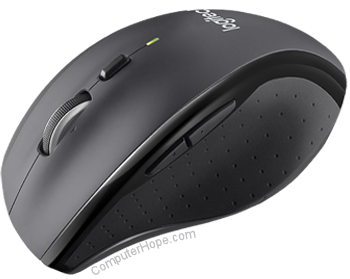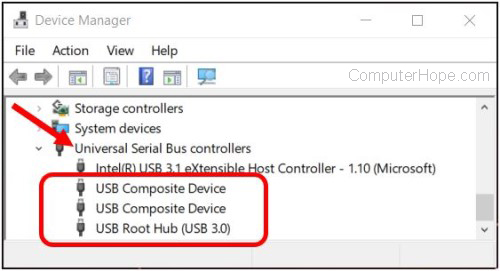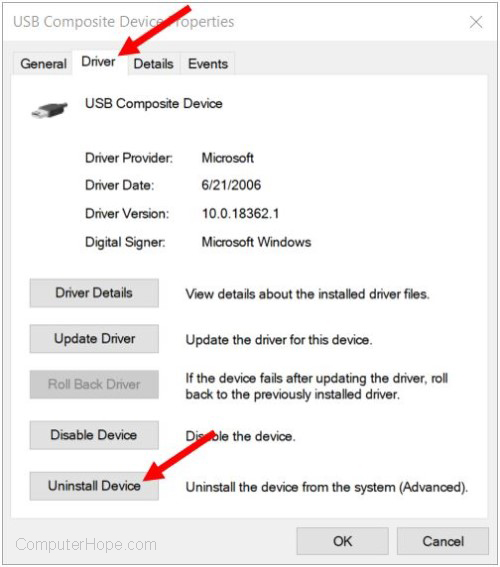What to Do if Your Mouse Isn T Working
Mouse not detected or working in Windows
Updated: 07/06/2021 by Computer Hope

If your mouse cursor isn't showing on your monitor, there may be several issues that cause the mouse not to work properly with Microsoft Windows. This page contains solutions that may help rediscover or unlock your mouse.
Tip
You can use your keyboard to navigate in Windows or connect a different mouse that does work to access areas of Windows mentioned on this page. For help navigating using a keyboard, see: How to navigate Windows using a keyboard.
- Computer frozen.
- Hardware conflict.
- Mouse is not connected correctly.
- Software or driver conflict.
- Mouse driver outdated or missing.
- Outdated USB driver.
- Other USB driver issues.
- Operating system files corrupted.
- Other hardware issues.
Computer frozen
When a computer freezes, the first sign is usually that the mouse has stopped responding on the monitor. If your mouse pointer movement disappears, follow these steps to determine if your computer is completely frozen.
Using the Num Lock key
Make sure the computer is not frozen by pressing the Num Lock key on the keyboard. When Num Lock is pressed repeatedly, the Num Lock indicator LED on your keyboard should turn on and off. If this indicator does not change, your computer is frozen; meaning all hardware on the computer (including the mouse) will not work. Reboot the computer to resolve this issue. If you don't have an indicator light, proceed to the next part of this section.
Keyboard doesn't have Num Lock indicator light
If your keyboard does not include the LED described in the previous section, anywhere in Windows, press the Ctrl+Alt+Del keys at the same time. This action should bring up a blue Windows options screen. You may leave this menu by pressing the Esc. If you are not taken to the blue screen within a few seconds, your computer is frozen. Reboot your machine to resolve this issue.
- Windows freezes or stops responding frequently.
Hardware conflict
If any new hardware was recently installed on the computer, remove it to help verify the new hardware is not causing a conflict with your existing mouse.
Mouse is not connected correctly
Follow these steps to verify the mouse is connected correctly to the computer.
USB mouse
If you are using a USB or cordless mouse, disconnect the mouse cable and reconnect to a different USB port. If the mouse connects to a USB hub, try connecting the mouse to a USB port on the back of the computer.
Wireless mouse
- Make sure the wireless mouse is receiving power by checking for some indication of power (usually a light). Move your mouse around on the mousepad to see if any indicator comes on. If your mouse has a power switch, it's often on the bottom side.
- If the mouse doesn't appear to be on, replace the batteries.
- Make sure the wireless receiver is within range and is not blocked by too many objects.
- Disconnect the wireless USB adapter and try plugging it into a different port.
PS/2 mouse

With a PS/2 mouse, check the back of the computer to verify that it's plugged into the PS/2 mouse port and not the PS/2 keyboard. If the mouse has worked properly in the past (i.e., not a new mouse), shut down the computer and disconnect and reconnect the mouse.
Note
A PS/2 mouse should not be disconnected and reconnected while a computer is turned on.
Tip
If the computer's keyboard works, shut down Windows properly by pressing the Windows key, and then using the arrow keys and Tab to select shut down.
Software or driver conflict
Boot into Windows Safe Mode. If the mouse is working in Safe Mode, there is likely a driver or software conflict. To fix this problem, follow the steps below.
- Open the Device Manager.
- Expand the mouse (mice) option in Device Manager by clicking the + symbol.
- Remove all mice listed by highlighting each device and then pressing the Del on the keyboard.
- Basic computer troubleshooting.
Mouse driver outdated or missing
Check if a driver is installed for the mouse. You can check in the Device Manager for this. While Windows may have a standard or default driver for the mouse, installing a driver for your specific mouse may fix the issue. Check our mouse manufacturers list for links to many mouse manufacturer websites to download a driver for the mouse.
If a driver is installed for the mouse, we recommend you check for an update released since the installation of the driver. Updating the driver may fix issues with a non-functioning mouse.
Outdated USB driver
Motherboard and computer manufacturers update hardware drivers periodically, including USB port drivers. USB mouse detection and functionality issues may be a result of outdated USB port drivers.
Updated USB port drivers can fix mouse detection and functionality issues. Check our computer manufacturers list and motherboard companies list for links to manufacturer websites. You can visit the website of your mouse manufacturer to check for updated USB port drivers. If updated drivers are available, download and install the new drivers. Restart your computer and test the mouse to see if the updated drivers fix the issue.
Other USB driver issues
If your USB mouse does not work on the computer, the USB port drivers may be corrupt. Two options for trying to fix corrupt drivers are to restore Windows to a previous point when the USB mouse did work, or uninstall and reinstall the USB port drivers.
Activate Windows restore point
If your USB mouse worked previously, activate a Windows restore point to a date when the mouse worked on your computer.
- How to restore Windows to an earlier copy.
Uninstall and reinstall USB port drivers
USB port drivers can get corrupted, causing a USB mouse not to work. Follow the steps below to uninstall and reinstall the USB port drivers.
- Open the Device Manager.
- Using the Tab and arrow keys, highlight the Universal Serial Bus controllers entry in the Device Manager.
- Press the right arrow key to expand the devices under Universal Serial Bus controllers.
- Use the arrow keys to highlight a USB Composite Device or USB Root Hub entry and press Enter to open the properties window.

- In the properties window, using the Tab and arrow keys, access the Driver tab.
- On the Driver tab, use the Tab key to select the Uninstall Device button, then press Enter.

- On the Uninstall Device window, use the Tab key to highlight the Uninstall button and press Enter.
- For each USB Composite Device or USB Root Hub entry in the Device Manager, repeat steps 4 through 7 above.
- After uninstalling each USB port devices, restart Windows and your computer.
- How to restart Microsoft Windows.
- When Windows loads, it should detect the USB port devices in your computer and reinstall them, including the drivers.
Operating system files corrupted
If the above solutions do not resolve the issue, there is a possibility of corrupt system files in the operating system. You may need to run an operating system repair using the system installation disc.
If you have a Windows restore point saved from when the mouse was working, restore your system to that state.
- How to restore Windows to an earlier copy.
Other hardware issues
These hardware issues may also apply to you.
Bad port
If the previous solutions did not solve the problem, try another mouse. If that mouse works, try the mouse that is not working with another computer. If multiple mice do not work, the problem is with the mouse port. If you're using the PS/2 or USB port on the back of the computer, the motherboard may be bad and needs to be replaced.
Bad mouse
If the mouse no longer works with any computer or the mouse wire is partially cut or frayed, the mouse needs to be replaced. It's cheaper to buy a new mouse than to try fixing a bad mouse.
What to Do if Your Mouse Isn T Working
Source: https://www.computerhope.com/issues/ch000254.htm